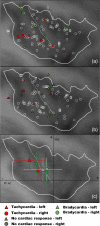How the insula speaks to the heart: Cardiac responses to insular stimulation in humans
- PMID: 30815964
- PMCID: PMC6865697
- DOI: 10.1002/hbm.24548
How the insula speaks to the heart: Cardiac responses to insular stimulation in humans
Abstract
Despite numerous studies suggesting the role of insular cortex in the control of autonomic activity, the exact location of cardiac motor regions remains controversial. We provide here a functional mapping of autonomic cardiac responses to intracortical stimulations of the human insula. The cardiac effects of 100 insular electrical stimulations into 47 epileptic patients were divided into tachycardia, bradycardia, and no cardiac response according to the magnitude of RR interval (RRI) reactivity. Sympathetic (low frequency, LF, and low to high frequency powers ratio, LF/HF ratio) and parasympathetic (high frequency power, HF) reactivity were studied using RRI analysis. Bradycardia was induced by 26 stimulations (26%) and tachycardia by 21 stimulations (21%). Right and left insular stimulations induced as often a bradycardia as a tachycardia. Tachycardia was accompanied by an increase in LF/HF ratio, suggesting an increase in sympathetic tone; while bradycardia seemed accompanied by an increase of parasympathetic tone reflected by an increase in HF. There was some left/right asymmetry in insular subregions where increased or decreased heart rates were produced after stimulation. However, spatial distribution of tachycardia responses predominated in the posterior insula, whereas bradycardia sites were more anterior in the median part of the insula. These findings seemed to indicate a posterior predominance of sympathetic control in the insula, whichever the side; whereas the parasympathetic control seemed more anterior. Dysfunction of these regions should be considered when modifications of cardiac activity occur during epileptic seizures and in cardiovascular diseases.
Keywords: RR intervals; autonomic nervous system; bradycardia; heart; insula; tachycardia.
© 2019 Wiley Periodicals, Inc.
Conflict of interest statement
The authors declare no conflict of interest.
Figures



Similar articles
-
Cardiac response to startle stimuli in larval zebrafish: sympathetic and parasympathetic components.Am J Physiol Regul Integr Comp Physiol. 2010 May;298(5):R1288-97. doi: 10.1152/ajpregu.00302.2009. Epub 2010 Feb 3. Am J Physiol Regul Integr Comp Physiol. 2010. PMID: 20130228
-
Central-peripheral neural network interactions evoked by vagus nerve stimulation: functional consequences on control of cardiac function.Am J Physiol Heart Circ Physiol. 2015 Nov 15;309(10):H1740-52. doi: 10.1152/ajpheart.00557.2015. Epub 2015 Sep 14. Am J Physiol Heart Circ Physiol. 2015. PMID: 26371171 Free PMC article.
-
Eyeball Pressure Stimulation Unveils Subtle Autonomic Cardiovascular Dysfunction in Persons with a History of Mild Traumatic Brain Injury.J Neurotrauma. 2015 Nov 15;32(22):1796-804. doi: 10.1089/neu.2014.3842. Epub 2015 Sep 23. J Neurotrauma. 2015. PMID: 26192266
-
Functional mapping of the human insula: Data from electrical stimulations.Rev Neurol (Paris). 2019 Mar;175(3):150-156. doi: 10.1016/j.neurol.2018.12.003. Epub 2019 Mar 1. Rev Neurol (Paris). 2019. PMID: 30827578 Review.
-
Reflexly evoked coactivation of cardiac vagal and sympathetic motor outflows: observations and functional implications.Clin Exp Pharmacol Physiol. 2006 Dec;33(12):1245-50. doi: 10.1111/j.1440-1681.2006.04518.x. Clin Exp Pharmacol Physiol. 2006. PMID: 17184509 Review.
Cited by
-
No Impact of Stochastic Galvanic Vestibular Stimulation on Arterial Pressure and Heart Rate Variability in the Elderly Population.Front Hum Neurosci. 2021 Feb 17;15:646127. doi: 10.3389/fnhum.2021.646127. eCollection 2021. Front Hum Neurosci. 2021. PMID: 33679355 Free PMC article.
-
An insula hierarchical network architecture for active interoceptive inference.R Soc Open Sci. 2022 Jun 29;9(6):220226. doi: 10.1098/rsos.220226. eCollection 2022 Jun. R Soc Open Sci. 2022. PMID: 35774133 Free PMC article. Review.
-
Integrative roles of human amygdala subdivisions: Insight from direct intracerebral stimulations via stereotactic EEG.Hum Brain Mapp. 2023 Jun 15;44(9):3610-3623. doi: 10.1002/hbm.26300. Epub 2023 Apr 19. Hum Brain Mapp. 2023. PMID: 37073861 Free PMC article.
-
Osteopathy modulates brain-heart interaction in chronic pain patients: an ASL study.Sci Rep. 2021 Feb 25;11(1):4556. doi: 10.1038/s41598-021-83893-8. Sci Rep. 2021. PMID: 33633195 Free PMC article.
-
Autonomic dysfunction after stroke: an overview of recent clinical evidence and perspectives on therapeutic management.Clin Auton Res. 2025 Aug;35(4):553-563. doi: 10.1007/s10286-025-01120-0. Epub 2025 Mar 25. Clin Auton Res. 2025. PMID: 40131648 Free PMC article. Review.
References
-
- Akselrod, S. , Gordon, D. , Ubel, F. A. , Shannon, D. C. , Berger, A. C. , & Cohen, R. J. (1981). Power spectrum analysis of heart rate fluctuation: A quantitative probe of beat‐to‐beat cardiovascular control. Science, 213, 220–222. - PubMed
-
- Benarroch, E. E. (1993). The central autonomic network: Functional organization, dysfunction, and perspective. Mayo Clinic Proceedings, 68, 988–1001. - PubMed
-
- Britton, J. W. , Ghearing, G. R. , Benarroch, E. E. , & Cascino, G. D. (2006). The ictal bradycardia syndrome: Localization and lateralization. Epilepsia, 47, 737–744. - PubMed
-
- Catenoix, H. , Mauguière, F. , Guénot, M. , Isnard, J. , & Ryvlin, P. (2013). Recording the insula during ictal asystole. International Journal of Cardiology, 169, e28–e30. - PubMed
MeSH terms
LinkOut - more resources
Full Text Sources
Research Materials
Miscellaneous

